Hornbostel–Sachs classification 53(Electrophone) Invented 1920 | Developed 1920 Inventor Léon Theremin | |
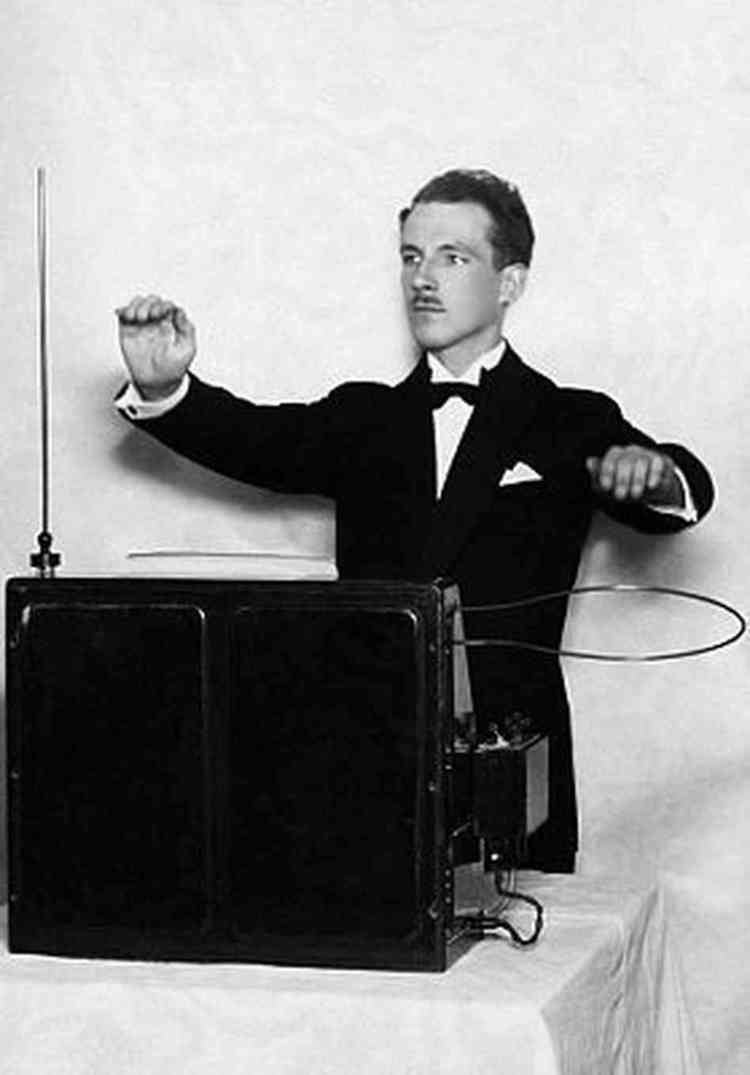 | ||
The theremin a short introduction to a unique instrument
The theremin (/ˈθɛrəmɪn/; originally known as the ætherphone/etherphone, thereminophone or termenvox/thereminvox) is an early electronic musical instrument controlled without physical contact by the thereminist (performer). It is named after the Westernized name of its Russian inventor, Léon Theremin (Термéн), who patented the device in 1928.
Contents
- The theremin a short introduction to a unique instrument
- Theremin over the rainbow
- History
- Operating principles
- Performance technique
- Concert music
- Popular music
- Film music
- Television
- Literature
- Video games
- First Theremin Concert for Extraterrestrials
- Similar instruments
- References

The instrument's controlling section usually consists of two metal antennas that sense the relative position of the thereminist's hands and control oscillators for frequency with one hand, and amplitude (volume) with the other. The electric signals from the theremin are amplified and sent to a loudspeaker.
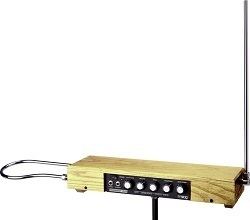
The theremin was used in movie soundtracks such as Miklós Rózsa's Spellbound, The Lost Weekend, and Bernard Herrmann's The Day the Earth Stood Still. It has also been used in theme songs for television shows such as the ITV drama Midsomer Murders. This has led to its association with eerie situations. Theremins are also used in concert music (especially avant-garde and 20th- and 21st-century new music) and in popular music genres such as rock.
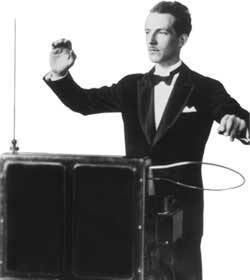
Theremin over the rainbow
History
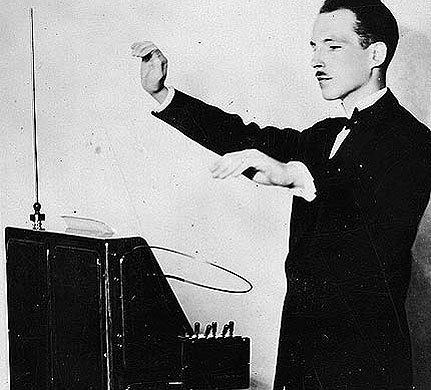
The theremin was originally the product of Soviet government-sponsored research into proximity sensors. The instrument was invented by a young Russian physicist named Lev Sergeyevich Termen (known in the West as Léon Theremin) in October 1920 after the outbreak of the Russian Civil War. After a lengthy tour of Europe, during which time he demonstrated his invention to packed houses, Theremin moved to the United States, where he patented his invention in 1928. Subsequently, Theremin granted commercial production rights to RCA.

Although the RCA Thereminvox (released immediately following the Stock Market Crash of 1929), was not a commercial success, it fascinated audiences in America and abroad. Clara Rockmore, a well-known thereminist, toured to wide acclaim, performing a classical repertoire in concert halls around the United States, often sharing the bill with Paul Robeson.
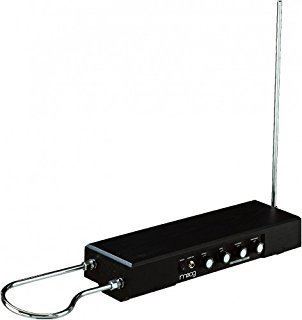
During the 1930s, Lucie Bigelow Rosen was also taken with the theremin and together with her husband Walter Bigelow Rosen provided both financial and artistic support to the development and popularisation of the instrument.
In 1938, Theremin left the United States, though the circumstances related to his departure are in dispute. Many accounts claim he was taken from his New York City apartment by NKVD agents (preceding the KGB), taken back to the Soviet Union and made to work in a sharashka laboratory prison camp at Magadan, Siberia. He reappeared 30 years later. In his 2000 biography of the inventor, Theremin: Ether Music and Espionage, Albert Glinsky suggested the Russian had fled to escape crushing personal debts, and was then caught up in Stalin's political purges. In any case, Theremin did not return to the United States until 1991.
After a flurry of interest in America following the end of the Second World War, the theremin soon fell into disuse with serious musicians, mainly because newer electronic instruments were introduced that were easier to play. However, a niche interest in the theremin persisted, mostly among electronics enthusiasts and kit-building hobbyists. One of these electronics enthusiasts, Robert Moog, began building theremins in the 1950s, while he was a high-school student. Moog subsequently published a number of articles about building theremins, and sold theremin kits that were intended to be assembled by the customer. Moog credited what he learned from the experience as leading directly to his groundbreaking synthesizer, the Moog. (Around 1955, a colleague of Moog's, electronic music pioneer Raymond Scott, purchased one of Moog's theremin subassemblies to incorporate into a new invention, the Clavivox, which was intended to be an easy-to-use keyboard theremin.)
Since the release of the film Theremin: An Electronic Odyssey in 1994, the instrument has enjoyed a resurgence in interest and has become more widely used by contemporary musicians. Even though many theremin sounds can be approximated on many modern synthesizers, some musicians continue to appreciate the expressiveness, novelty, and uniqueness of using an actual theremin. The film itself has garnered excellent reviews.
Both theremin instruments and kits are available from manufacturers such as Moog Music Inc., Burns Theremins, Harrison Instruments, Inc., Theremaniacs LLC, PAiA Corporation USA, and Jaycar Electronics. Some inexpensive theremins may only have a pitch control and may be harder to play accurately because of a relatively non-linear relationship between the distance of the hand and resultant pitch, as well as a relatively short span of hand-to-antenna distance for producing the available range of pitch.
Operating principles
The theremin is distinguished among musical instruments in that it is played without physical contact. The thereminist stands in front of the instrument and moves his or her hands in the proximity of two metal antennas. The distance from one antenna determines frequency (pitch), and the distance from the other controls amplitude (volume). Higher notes are played by moving the hand closer to the pitch antenna. Louder notes are played by moving the hand away from the volume antenna. Most frequently, the right hand controls the pitch and the left controls the volume, although some performers reverse this arrangement. Some low-cost theremins use a conventional, knob operated volume control and have only the pitch antenna. While commonly called antennas, they are not used for receiving or broadcasting radio waves, but act as plates of capacitors.
The theremin uses the heterodyne principle to generate an audio signal. The instrument's pitch circuitry includes two radio frequency oscillators set below 500 kHz to minimize radio interference. One oscillator operates at a fixed frequency. The frequency of the other oscillator is almost identical, and is controlled by the performer's distance from the pitch control antenna. The performer's hand acts as the grounded plate (the performer's body being the connection to ground) of a variable capacitor in an L-C (inductance-capacitance) circuit, which is part of the oscillator and determines its frequency. In the simplest designs, the antenna is directly coupled to the tuned circuit of the oscillator and the 'pitch field' that is the change of note with distance, is highly nonlinear, as the capacitance change with distance is far greater near the antenna. In such systems, when the antenna is removed, the oscillator moves up in frequency.
To partly linearise the pitch field, the antenna may be wired in series with an inductor to form a series tuned circuit, resonating with the parallel combination of the antenna's intrinsic capacitance and the capacitance of the player's hand in proximity to the antenna. This series tuned circuit is then connected in parallel with the parallel tuned circuit of the variable pitch oscillator. With the antenna circuit disconnected, the oscillator is tuned to a frequency slightly higher than the stand alone resonant frequency of the antenna circuit. At that frequency, the antenna and its linearisation coil present an inductive impedance; and when connected, behaves as an inductor in parallel with the oscillator. Thus, connecting the antenna and linearising coil raises the oscillation frequency. Close to the resonant frequency of the antenna circuit, the effective inductance is small, and the effect on the oscillator is greatest; farther from it, the effective inductance is larger, and fractional change on the oscillator is reduced. When the hand is distant from the antenna, the resonant frequency of the antenna series circuit is at its highest; i.e., it is closest to the free running frequency of the oscillator, and small changes in antenna capacitance have greatest effect. Under this condition, the effective inductance in the tank circuit is at its minimum and the oscillation frequency is at its maximum. The steepening rate of change of shunt impedance with hand position compensates for the reduced influence of the hand being further away. With careful tuning, a near linear region of pitch field can be created over the central 2 or 3 octaves of operation. Using optimized pitch field linearisation, circuits can be made where a change in capacitance between the performer and the instrument in the order of 0.01 picofarads produces a full octave of frequency shift.
The mixer produces the audio-range difference between the frequencies of the two oscillators at each moment, which is the tone that is then wave shaped and amplified and sent to a loudspeaker.
To control volume, the performer's other hand acts as the grounded plate of another variable capacitor. As in the tone circuit, the distance between the performer's hand and the volume control antenna determines the capacitance and hence natural resonant frequency of an LC circuit inductively coupled to another fixed LC oscillator circuit operating at a slightly higher resonant frequency. When a hand approaches the antenna, the natural frequency of that circuit is lowered by the extra capacitance, which detunes the oscillator and lowers its resonant plate current. In the earliest theremins, the RF plate current of the oscillator is picked up by another winding and used to power the filament of another diode-connected triode, which thus acts as a variable conductance element changing the output amplitude. The harmonic timbre of the output, not being a pure tone, was an important feature of the theremin. Theremin's original design included audio frequency series/parallel LC formant filters as well as a 3-winding variable-saturation transformer to control or induce harmonics in the audio output.
Modern circuit designs often simplify this circuit and avoid the complexity of two heterodyne oscillators by having a single pitch oscillator, akin to the original theremin's volume circuit. This approach is usually less stable and cannot generate the low frequencies that a heterodyne oscillator can. Better designs (e.g., Moog, Theremax) may use two pairs of heterodyne oscillators, for both pitch and volume.
Performance technique
Important in theremin articulation is the use of the volume control antenna. Unlike touched instruments, where simply halting play or damping a resonator in the traditional sense silences the instrument, the thereminist must "play the rests, as well as the notes", as Clara Rockmore observed. If the pitch hand is moved between notes, without first lowering the volume hand, the result is a "swooping" sound akin to a swanee whistle or a glissando played on the violin. Small flutters of the pitch hand can be used to produce a vibrato effect. To produce distinct notes requires a pecking action with the volume hand to mute the volume while the pitch hand moves between positions. Thereminists such as Carolina Eyck use a fixed arm position per octave, and use fixed positions of the fingers to create the notes within the octave, allowing very fast transitions between adjacent notes. Although volume technique is less developed than pitch technique, some thereminists have worked to extend it, especially Pamelia Kurstin with her "walking bass" technique and Rupert Chappelle.
Recent versions of the theremin have been functionally updated: the Moog Ethervox, while functionally still a theremin, can also be used as a MIDI controller, and as such allows the artist to control any MIDI-compatible synthesizer with it, using the theremin's continuous pitch to drive modern synths. The Harrison Instruments Model 302 Theremin uses symmetrical horizontal plates instead of a vertical rod and horizontal loop to control pitch and volume, with the volume increasing as the hand approaches the plate.
The critic Harold C. Schonberg described the sound of the theremin as "(a) cello lost in a dense fog, crying because it does not know how to get home."
Concert music
Concert composers who have written for theremin include Bohuslav Martinů, Percy Grainger, Christian Wolff, Joseph Schillinger, Moritz Eggert, Iraida Yusupova, Jorge Antunes, Vladimir Komarov, Anis Fuleihan, and Fazıl Say. Another large-scale theremin concerto is Kalevi Aho's Concerto for Theremin and Chamber Orchestra "Eight Seasons" (2011), written for Carolina Eyck.
Maverick composer Percy Grainger chose to use ensembles of four or six theremins (in preference to a string quartet) for his two earliest experimental Free Music compositions (1935–37) because of the instrument's complete 'gliding' freedom of pitch.
Musician Jean Michel Jarre used the instrument in his concerts Oxygen In Moscow and Space of Freedom in Gdańsk, providing also a short history of Léon Theremin's life.
The five-piece Spaghetti Western Orchestra use a Theremin as a replacement for Edda Dell'Orso's vocals in their interpretation of Ennio Morricone's "Once Upon a Time in the West".
Other notable contemporary Theremin players include Lydia Kavina, Pamelia Kurstin, Barbara Buchholz and Katica Illényi. Dutch classical musician Thorwald Jørgensen has been described as "one of the most important exponents of classical music on the theremin".
On 20 July 2013, a group of 272 theremin players (Matryomin ensemble) in Hamamatsu, Shizuoka, Japan, achieved a Guinness world record as the largest theremin ensemble. The name Matryomin is a portmanteau of the words matryoshka and theremin.
Popular music
Theremins and theremin-like sounds started to be incorporated into popular music from the end of the 1940s (with a series of Samuel Hoffman/Harry Revel collaborations) and this has continued, with varying popularity, to the present.
The Beach Boys' 1966 single "Good Vibrations" – though it does not technically contain a theremin – is the most frequently cited example of the instrument in pop music. The song actually features a type of theremin invented by Paul Tanner called an Electro-Theremin. Upon release, the single prompted an unexpected revival in theremins and increased the awareness of analog synthesizers. In response to requests by the band, Moog Music began producing their own brand of ribbon-controlled instruments which would mimic the sound of a theremin.
Jimmy Page of Led Zeppelin used a variation of the theremin (minus the loop) during performances of "Whole Lotta Love" and "No Quarter" throughout the performance history of Led Zeppelin, an extended multi-instrumental solo featuring theremin and bowed guitar in 1977, as well as the soundtrack for Death Wish II released in 1982.
Brian Jones of the Rolling Stones also used the instrument on the group's 1967 albums Between the Buttons and Their Satanic Majesties Request.
The Lothars are a Boston-area band formed in early 1997 whose CDs have featured as many as four theremins played at once – a first for pop music.
Although credited with a "Thereman" [sic] on the "Mysterons" track from the album Dummy, Portishead actually used a monophonic synthesizer to achieve theremin-like effects, as confirmed by Adrian Utley, who is credited as playing the instrument; he has also created similar sounds on the songs "Half Day Closing", "Humming", "The Rip", and "Machine Gun".
Film music
Russian composer Dmitri Shostakovich was one of the first to incorporate parts for the theremin in orchestral pieces, including a use in his score for the film Odna (Russian: Одна – 1931, Leonid Trauberg and Grigori Kozintsev). While the theremin was not widely used in classical music performances, the instrument found great success in many motion pictures, notably, Spellbound, The Red House, The Lost Weekend (all three of which were written by Miklós Rózsa, the composer who pioneered the use of the instrument in Hollywood scores), The Spiral Staircase, Rocketship X-M, The Day the Earth Stood Still, The Thing (From Another World), and The Ten Commandments (the 1956 DeMille film). The theremin is played and identified as such in use in the Jerry Lewis movie The Delicate Delinquent. The theremin is prominent in the score for the 1956 short film "A Short Vision", which was aired on The Ed Sullivan Show the same year that it was used by the Hungarian composer Matyas Seiber. More recent appearances in film scores include Monster House, Ed Wood and The Machinist (both featuring Lydia Kavina).
A theremin was not used for the soundtrack of Forbidden Planet, for which Louis and Bebe Barron built disposable oscillator circuits and a ring modulator to create the electronic tonalities used in the film.
Los Angeles-based thereminist Charles Richard Lester is featured on the soundtrack of Monster House and has performed the US premiere of Gavriil Popov's 1932 score for Komsomol – Patron of Electrification with the L. A. Philharmonic and Esa-Pekka Salonen in 2007.
In Lenny Abrahamson's 2014 film, Frank, Clara, the character played by Maggie Gyllenhaal, plays the theremin in a band named Soronprfbs.
Television
Literature
Video games
First Theremin Concert for Extraterrestrials
See Teen Age MessageThe First Theremin Concert for Extraterrestrials was the world's first musical Active SETI broadcast, and was sent seven years before NASA's Across the Universe message.
